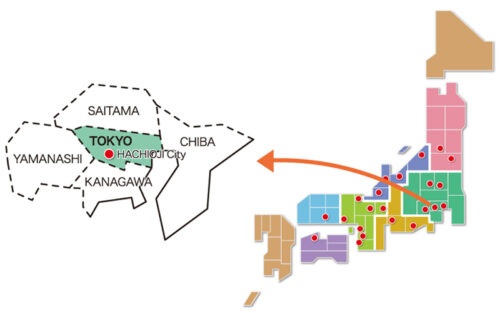Hachioji Region
Renowned for its Tama Ori (Tama woven fabrics) and ties

The Hachioji textile region in Tokyo has also earned the title ‘Soto’ (Capital of mulberries) and has long prospered with the business of raising silkworms and producing silk fabrics. In Edo times, the main outputs were yarn-dyed stripe-patterned fabrics for men’s kimonos. Later, efforts channelled to dyeing eventually spawned the Hachioji dyeing training school, followed by the Tokyo Prefectural Weaving & Dyeing School in the Meiji Period (1868-1912). In terms of looms, Edo weavers used so-called ‘Takahata’ (traditional Japanese treadle-operated tall looms), before the process was gradually automated and dobby/jacquard techniques were added in the Meiji Period.
As the Taisho Period (1912-1926) started and menswear became increasingly westernised, the region refocused on fabric rolls for women’s kimonos and ties and even to this day, Hachioji remains one of the leading tie producers nationwide. Although factories in the region were devastated by Hachioji air raids during the Pacific War (1941-45), the industry reinvented itself with a new set of products, including: ‘Meisen’ silk textiles, pure silk ties, umbrella cloths, scarves, mufflers, and/or figured wool fabrics. Their specialty, ‘Tama Ori’ (Tama woven fabric), is a general term for silk fabric variants including ‘Tama Yuki’(with a crepe-like texture), ‘Futsu Ori’ (double-layered) and ‘Tsumugi Ori’ (uneven texture). Collectively, they represent traditional national craftwork and are often used for kimono rolls and coats. There are even factories adapted as DC brands (‘designer and character brands’: created by Japanese apparel companies), optimally exploiting the favourable Tokyo location.
